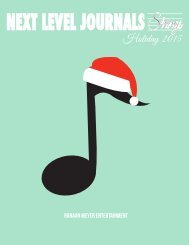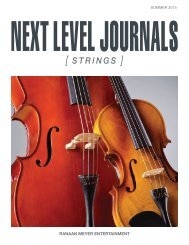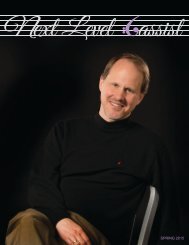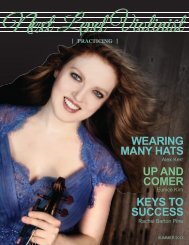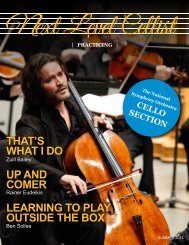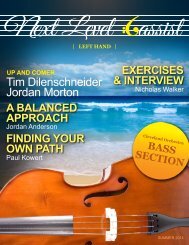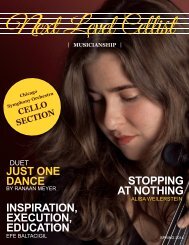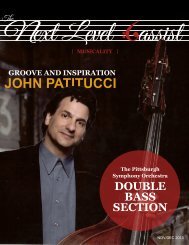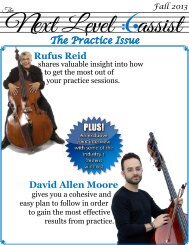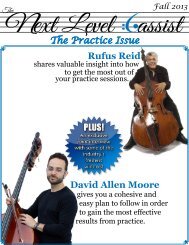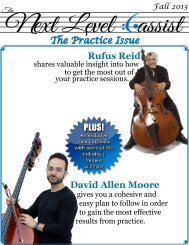SPRING 2015
You also want an ePaper? Increase the reach of your titles
YUMPU automatically turns print PDFs into web optimized ePapers that Google loves.
<strong>SPRING</strong> <strong>2015</strong>
Contents<br />
Spring <strong>2015</strong><br />
Publisher’s Note<br />
FEATURED<br />
Interview with William Preucil 5<br />
Interview with Joshua Bell 8<br />
CONTRIBUTORS<br />
Ranaan Meyer<br />
Publisher/Founder<br />
Brent Edmondson<br />
Editor/Sales<br />
Karen Han<br />
Art Director/Designer<br />
I<br />
don’t think I could have asked for a more explosive issue of our journals!<br />
This issue on the modern career includes two of the great figures in violin<br />
playing today, Joshua Bell and William Preucil. Few musicians ever achieve<br />
the level of fame and recognition of these two masters, but the world<br />
benefits from their expertise, and thousands of violinists receive inspiration<br />
and guidance every day from the work they have done. Our hope is that<br />
some of the wisdom they share here may one day open the door for the next<br />
superstar violinist.<br />
This issue was designed around the modern career because there is a major<br />
change coming in the classical music world. A lot of ink has been spilled<br />
bemoaning the state of our industry, but musicians are blazing new paths<br />
every day and showing that audiences are still as enthusiastic as ever.<br />
In fact, the time has never been better for musicians to make their living<br />
as performers, entrepreneurs, and citizens of the world.<br />
Preucil’s experience in so many different settings, from his days as first violinist<br />
of the Cleveland Quartet through his many exploits as concertmaster, has given<br />
him unique perspectives on music and the great composers. He shares a great<br />
deal of insight on taking advantage of the situations you find yourself in, and<br />
always working toward the next goal. Preucil’s concertmaster training program<br />
is fascinating to me - the opportunity to get practical and hands-on training for<br />
your dream job from one of the undisputed experts in the field! Beyond honing<br />
your playing, imagine having an opportunity to lead your incredibly skilled<br />
peers and get constructive feedback in a safe environment. It’s not a resource<br />
many musicians get in their careers!<br />
Joshua Bell has become one of the most recognized figures in classical music,<br />
achieving the "household name" status that most dream of and few realize.<br />
From his days as a childhood prodigy to his present role as performer, music<br />
director, and philanthropist, Bell has made his way in the world by engaging<br />
and playing at the highest level. His thoughts on style and historically informed<br />
performance are especially interesting considering he is the successor of<br />
Sir Neville Marriner as music director of The Academy of St. Martin in the<br />
Fields. Fans of Josef Gingold’s pedagogy will find a warm reminiscent tone in<br />
Bell’s references to him, as well as some great perspective on the building of<br />
a great artist.<br />
I hope that in your exploration of this journal, you find inspiration<br />
and direction for your own career. The path may or may not be clear,<br />
but the time is right for you to follow your dreams!<br />
RANAAN MEYER<br />
Publisher Next Level Journals<br />
Ranaan Meyer<br />
Time for Three Founder and Bassist<br />
Education We All Deserve Foundation<br />
Founder<br />
Ranaan Meyer Entertainment<br />
Indianapolis Symphony Artist in Residence<br />
Sun Valley Summer Symphony Artist<br />
and Composer in Residence<br />
Charley Creek Arts Festival Artistic Director<br />
2 NOV/DEC <strong>SPRING</strong> <strong>2015</strong> 2013 NEXT LEVEL VIOLINIST<br />
BASSIST<br />
<strong>SPRING</strong> <strong>2015</strong> NEXT LEVEL VIOLINIST 3
Next Level Journals is made possible in part by Robertson and Sons Violin Shop<br />
Interview with<br />
WILLIAM PREUCIL<br />
I learned a lot in that position, and I<br />
continue to learn a lot to this day.<br />
At that point, I thought I would have<br />
a long career in orchestras, and it<br />
was something I really loved doing.<br />
When did you start to view<br />
teaching as a calling?<br />
When you set out to play music,<br />
what did you hope to be doing with<br />
the violin at this point in your life,<br />
or with music in general?<br />
As I was growing up, my father played<br />
in a string quartet. I went to a lot of<br />
string quartet concerts, I went on<br />
tour with him a couple of times, and<br />
I just had it in my mind that I was<br />
going to play in a string quartet. I<br />
love the repertoire and it seemed<br />
like a natural fit. The first thing I did<br />
when I went away to school was<br />
to get involved in playing quartets.<br />
While I attended Indiana University,<br />
I had the opportunity to play in one<br />
of the school orchestras as concertmaster<br />
and I really enjoyed that, and<br />
I got some positive feedback about<br />
it. I hadn’t really found people with<br />
chemistry or commitment to start<br />
a string quartet, but there were a<br />
couple of orchestra jobs open. I<br />
applied to those orchestras and was<br />
accepted at one, because I was just<br />
out of school. I was lucky enough to<br />
be asked to take the concertmaster<br />
job in the Nashville Symphony.<br />
I think they were taking a chance<br />
on me being unknown but they felt<br />
good about my audition. I started out<br />
my orchestral career in Nashville and<br />
I believe it was a positive experience.<br />
I started to do a bit of teaching<br />
in my last few years in college. It’s<br />
a wonderful feeling when you help<br />
somebody. I had a few students at<br />
local universities when I was playing<br />
in Nashville, Utah, and Atlanta.<br />
When I moved to Rochester to join<br />
the Cleveland Quartet in residency<br />
at the Eastman School, all of a<br />
sudden I had a class of 10-12 students,<br />
and I found that I really enjoyed<br />
working with them. When I moved<br />
to Cleveland in 1995, I started off<br />
with a class about that size at the<br />
Cleveland Institute, which has grown<br />
much larger since then. I made a<br />
large time and personal commitment<br />
to teaching. If I had more time, I would<br />
love to do more private teaching<br />
and chamber music coaching.<br />
How did your career’s evolution,<br />
from Nashville to Cleveland, shape<br />
you as a player?<br />
One of the benefits I have found from<br />
having a career of both orchestral<br />
and chamber music is a very broad<br />
knowledge of all or most of the<br />
works that a given composer wrote.<br />
It helps in figuring out a Beethoven<br />
sonata when you have played his<br />
string quartets, his orchestral music,<br />
his symphonies, and so many other<br />
works of his. It widens the repertoire<br />
that you can draw on to understand<br />
a new work.<br />
What do you feel you learned<br />
from performing with a variety<br />
of ensembles?<br />
I have learned a great deal from the<br />
responsibility of leadership entrusted<br />
to me as the concertmaster of the<br />
orchestra. The issues in each orchestra<br />
are the same; we all want to keep<br />
it together! Sometimes that needs<br />
work and I’m one of the people in<br />
the orchestra that can help with that.<br />
When working with a lot of different<br />
conductors, the beats are very<br />
4 <strong>SPRING</strong> <strong>2015</strong> NEXT LEVEL VIOLINIST<br />
<strong>SPRING</strong> <strong>2015</strong> NEXT LEVEL VIOLINIST 5
different. Some things need to be the same week to<br />
week, and often that can be the concertmaster. I think<br />
you get used to doing that, and you can draw on it<br />
for other settings. When you go to a chamber music<br />
festival, you get to have two rehearsals on a piece and<br />
then perform it. The idea is the same - being very clear<br />
and strong about what you’re doing, leading while<br />
making sure everybody is happy with the product<br />
and contributing fully.<br />
Can you name some of the skills that you think make<br />
the best people in the industry who they are?<br />
There are all the fundamental elements like rhythm,<br />
intonation, good sound and of course there’s the<br />
mysterious thing of what we call being musical and<br />
making something artistic happen. What’s important<br />
in the end is capturing the expression of the music and<br />
projecting that to the listeners so they have an experience.<br />
We try to interpret what the composer meant and what<br />
he wants us to feel when we play, what he wants people<br />
to feel when they listen. All those other basics allow you<br />
to play the instrument well enough, so that you’re able<br />
to express yourself the way you want to, not only<br />
emotionally but sonically.<br />
In terms of skills related to the concertmaster chair,<br />
there’s physical motion of leadership, trying to get the<br />
notes together or leading the shape of a phrase or showing<br />
dynamics. A lot of this is extremely visual. The physical<br />
motions should fit with the music, rather than being<br />
forced upon it. Ten years ago when I started this training<br />
program for concertmasters, one of the things I would<br />
do with the students is sit in the chair behind them and<br />
have them lead me through a piece. I would give them<br />
feedback on how clear they were, whether I could tell<br />
what they wanted me to do or where I was supposed to<br />
play. I had to learn how to teach others something that<br />
was instinct for me: getting other musicians to play a<br />
certain way based on my body language. I have spent<br />
a lot of time learning how I lead so I can train others to<br />
transmit their intentions and phrasing in this context.<br />
Part of the training process is giving students the freedom<br />
to experiment. We are all going to make mistakes<br />
professionally, but I try to set up an environment where<br />
the student can learn from them and use them to find<br />
the formula that will yield the best results. The ultimate<br />
goal is a sort of “translation,” because the concertmaster<br />
has the job of working with many different conductors<br />
throughout a season and helping deliver their message<br />
to the orchestra. That skill is vital to helping the orchestra<br />
stay together - unifying the way the musicians react to<br />
the beat being given and interpreting things like facial<br />
expressions from the conductor. It’s about constantly<br />
changing and learning from mistakes and experimenting.<br />
Thomas Edison made a lot of light bulbs before he<br />
got to the one that works.<br />
When you are teaching at this high level, do you use<br />
any books or materials consistently?<br />
Most of the students that I interact with on the collegiate<br />
level have already learned their scales, and although I<br />
hear them during the course of our studies, I mostly trust<br />
them to have that technical work done. There are a couple<br />
of etude books I like to use, mostly with undergraduates,<br />
and I have a couple of shifting exercises adapted from<br />
Janos Starker’s treatise on cello playing. I also like to pull<br />
technical examples from the repertoire they’re working<br />
on. I assess what a new student has worked on before<br />
and I choose the repertoire that will allow us to develop<br />
all the different techniques that a student will need to<br />
have a professional career - different bowings, upbow<br />
staccato, left hand pizz, some of the virtuosic techniques.<br />
I think it is important to work on technique in a musical<br />
context so that students are not only working on<br />
exercises as they practice but growing as musicians too.<br />
Would you mind elaborating on the<br />
Starker adaptation for shifting?<br />
Janos Starker, along with my teacher Josef Gingold, were<br />
two very influential musicians with incredible pedagogical<br />
resources. He wrote a book called “An Organized Method<br />
of String Playing” for the cello, and he was an early<br />
adopter of our modern string playing style - fewer audible<br />
shifts and narrower vibrato. Shifting is a big part of playing<br />
any string instrument. As the instrument gets bigger,<br />
it becomes an even bigger part. He had this wonderful<br />
simple idea of practicing any shift that you have to do<br />
from any note to any note. It’s an organized exercise that<br />
you practice a couple kinds of shifts from one note to<br />
another note and you start at a different place every day<br />
so by the time you get through the whole thing you’ve<br />
had a chance to practice any shift you’re ever going to<br />
come across, any finger combination. Once you have<br />
mastered the principle of shifting, you move from merely<br />
finding the right note to finding it with a specific expressive<br />
intention. You could expand your imagination by practicing<br />
the kind of shifting called for in a very expressive piece<br />
by Brahms, Wieniawski, or Vieuxtemps. The idea is<br />
that when you’ve gotten to the point where you feel<br />
comfortable with all the technical things that you’re<br />
working on, then trying to practice the artistic way you<br />
want to shift, the artistic way you want to play a phrase,<br />
and the real fun parts.<br />
How do you become a concertmaster? What would<br />
you say to someone who aspires to that position?<br />
The first thing to realize is that as far as the actual sound<br />
coming out of the violin, 99.99% of the time, you’re a<br />
section player. You have to know how to blend your<br />
sound at the same time you’re trying to lead something<br />
musically like shaping a phrase, or technically, like getting<br />
a chord together. There are some remarkable solo playing<br />
moments, like Ein Heldenleben where the violin is quite<br />
featured as a soloist. It’s still such a small percentage of<br />
the time that I don’t think it’s the ultimate consideration<br />
for a concertmaster. They are looking for someone with<br />
the ability, wherever it comes from, to bring a large<br />
section together not only technically but musically.<br />
There’s no substitute for having the chance to try it,<br />
learn what works and learn what doesn’t. You can get<br />
a sense listening to somebody play if they have honed<br />
that ability, that flexibility in music making. In terms of<br />
ensemble, if we were playing metronomically, it wouldn’t<br />
be that hard to stay together. Great music making uses<br />
and manipulates rhythm all the time, so having that<br />
flexibility is important for everyone in the orchestra<br />
and represents an excellent shared goal.<br />
How do you identify the students that you want<br />
to work with?<br />
I guess I’m looking for a little of what I have described<br />
above. I’m seeking flexibility, somebody who’s not just<br />
technically accomplished but has artistic goals and<br />
sensibilities. I also like them to be hard workers and show<br />
up on time, good personal discipline. I’m not looking for<br />
all these skills to be totally developed, but a prospective<br />
student has to aspire to those things in their playing.<br />
A student’s playing should demonstrate that they are<br />
aware of the existence of greater artistic and musical<br />
goals. If a student were to come to me with technical<br />
perfection already achieved, what would I teach them?<br />
I am not necessarily seeking a finished product, but I’m<br />
looking for the potential and drive to be a great player.<br />
This makes for a very enjoyable relationship because<br />
some lessons are about technique, some are about<br />
artistry and expression and different options. I have<br />
no desire to produce students that all sound the same -<br />
they are freely encouraged to craft a unique style because<br />
there is more than one good way to do something.<br />
What one person may want to express is not the same<br />
as another person. They can both be beautiful and be<br />
right - or at least not wrong!<br />
What is your organizational approach to teaching?<br />
Do you have all your ideas written down?<br />
Over the years, Steve Rose and I have marked a lot of<br />
parts for standard audition excerpts and they are available<br />
to students for reference. I have a book of markings for<br />
concertmaster solos as well. In lessons, things change.<br />
For one person, a different bowing might work better,<br />
fingerings are certainly personal. One goal in my lessons<br />
is showing different options to maximize comfort<br />
without sacrificing quality of sound.<br />
When you go into an audition, you need to be as<br />
comfortable as possible. It takes experience learning<br />
how to deliver a fine performance in a pressure situation.<br />
The strategy that weekly lessons take shifts around<br />
auditions, and we focus on the repertoire over multiple<br />
lessons, taking the music apart and building it back up<br />
for maximum ease and comfort. It helps to keep in mind<br />
that there’s not one tempo for each excerpt, there’s a<br />
ballpark. As long as the music doesn’t have a strained<br />
quality, individuals can play faster or slower within<br />
that acceptable range.<br />
Can you talk about how your recordings<br />
of excerpts came about?<br />
Summit Records set out to create an album of orchestral<br />
excerpts for each instrument, and asked me to do the<br />
violin recordings. My friend John Mack did the oboe one<br />
and thought it was a great idea. I didn’t know how hard<br />
it was going to be, but I hope I have created a lasting<br />
resource for violinists. ■<br />
6 <strong>SPRING</strong> <strong>2015</strong> NEXT LEVEL VIOLINIST<br />
<strong>SPRING</strong> <strong>2015</strong> NEXT LEVEL VIOLINIST 7
Joshua<br />
Bell<br />
8 <strong>SPRING</strong> <strong>2015</strong> NEXT LEVEL VIOLINIST<br />
<strong>SPRING</strong> <strong>2015</strong> NEXT LEVEL VIOLINIST 9
Next Level Journals is made possible in part by Robertson and Sons Violin Shop<br />
You succeeded Neville Marriner as the Music Director of<br />
Academy of St Martin in the Fields, and recently recorded an<br />
album of Bach concerti with them. How has your collaboration<br />
with this group shaped your approach to playing Bach?<br />
The Academy embodies my idea of how to approach early music.<br />
They’re an extremely skilled group of musicians with a lot of<br />
experience playing in early music groups such as the Academy of<br />
Ancient Music. Most of them are totally comfortable with stylistic<br />
extremes and bring many great Baroque music sensibilities, yet they<br />
aren’t overly obsessed with it. For instance, they don’t tune down to<br />
A=415, which I’ve always found personally to be very frustrating<br />
as a player and essentially unnecessary. I try to find a balance<br />
between the modern approach, the way I was taught and brought up<br />
playing my instrument, and the concepts of Historically Informed<br />
Performance, which are new to me even though they have roots<br />
going very far back. When it comes to Bach specifically, I think<br />
the Academy perfectly blends a modern approach and Historically<br />
Informed sensibilities.<br />
The repertoire we cover extends beyond Baroque music, and includes<br />
all periods right up to the modern day. One of the most exciting<br />
elements I’ve been personally involved in is this revolution in the<br />
approach to Beethoven’s 9 symphonies, which I have been starting<br />
to record with them as well.<br />
How diverse is the repertoire that you cover with them?<br />
The orchestra is very flexible. While the orchestra began as a<br />
conductorless string ensemble, it made its name performing Baroque<br />
music in a time when that wasn’t nearly as common as it is now. Today,<br />
we perform repertoire ranging from Bach and Vivaldi all the way up<br />
through modern works, and we’re commissioning some new pieces<br />
for the orchestra now. They’re very flexible, highly experienced, and<br />
(most importantly) they’re highly adaptable. They’re adept at learning<br />
and adjusting their playing quickly. I’m always amazed at how much<br />
less rehearsal time I need relative to other orchestras. They adjust<br />
so intuitively, and pick up on ideas so quickly. They play like chamber<br />
musicians, the highest ideal of collaboration and understanding -<br />
this seems like something that should be intuitive when it comes to<br />
great orchestras, but this is a really unique asset.<br />
Since I became music director in 2011, we’ve played in nearly every<br />
style and genre conceivable. It’s been one of the great experiences<br />
of my career. I’m still learning from them, learning with them,<br />
and having a blast!<br />
You have an HBO special coming up where you collaborated<br />
with YoungArts. From an education standpoint, what impact<br />
do you hope to leave on the world?<br />
I’d like to leave my mark in a couple ways. On a bigger scale, I’d like<br />
to help large numbers of young people have access to classical music.<br />
One of the organizations I work with to accomplish this is called<br />
Education Through Music (etmonline.org). They install music<br />
programs in inner-city schools that don’t have the resources to field<br />
their own music programs. I think I can help the art form on a grand<br />
scale by making sure that more young people have access to classical<br />
music as students.<br />
It’s also very gratifying to leave your mark on individuals. I enjoy<br />
the one-on-one experience working with young people at Indiana<br />
University, as well as in the upcoming HBO special, working with<br />
a small group of students. Feeling like you’re making an impact on<br />
someone, seeing the lightbulb go on in their heads or changing their<br />
thinking - that’s very rewarding! It seems I’m reaching the stage<br />
in my life where I’m starting to think about those things more. I’m<br />
certainly not ready to pack it in at this point, but I’m looking forward<br />
to doing more to give back. I’ve gotten so much from so many people<br />
and I would like to pay that forward.<br />
I haven’t yet had the experience of taking someone under my wing<br />
and following their progress for years. It’s something I would like to<br />
do, find perhaps one or two students to really take on and go the<br />
extra mile for. I haven’t had the time to commit to one person. When<br />
I go to Indiana University, I don’t have my own class - I make myself<br />
available to those students that would like to play for me. I would like<br />
to establish continuity with an individual and help him or her to grow.<br />
That being said, I believe the way we learn is by taking a little bit of<br />
information from a variety of sources. I took in knowledge from a lot<br />
of great people, and my teacher Josef Gingold really encouraged me<br />
to play for lots of different people. I went to masterclasses, I played<br />
for other teachers at IU, and I always got reassured by Gingold<br />
that it was the right path to take.<br />
I’m wary of students that look at their teachers as gurus and follow<br />
them like religious fanatics. The students of these teachers all play the<br />
same pieces, have the same fingerings for everything, and they follow<br />
one way of thinking. I think it’s important for young people to assimilate<br />
many philosophies and distill them into their own artistic outlook.<br />
What are some experiences you had studying with<br />
Josef Gingold that took you to the next level?<br />
Gingold was not a dogmatic teacher, and he never spoon-fed ideas to<br />
me. The thing I remember first from him was the physics of playing.<br />
He had this incredible facility on the instrument! He also had an<br />
incredibly beautiful sound. When he would talk, he would always ask<br />
questions rather than give answers, finding ways to guide me so that<br />
I would make my own discoveries. It gave me confidence in myself -<br />
when I would start a new piece, I wouldn’t ask my teacher about how<br />
to start it, I would look inside myself. This was especially important<br />
once I didn’t have a teacher any more.<br />
Gingold had a tremendous influence on my interpretation of Romantic<br />
repertoire, especially when it came to timing and rubato. A lot of this<br />
came from listening to him play, hearing the old style of playing that<br />
he came from and revered. It’s something that’s very hard to teach,<br />
the way of subtly taking time and giving it back the way old masters<br />
like Heifetz and Kreisler did.<br />
As for Bach, when I was growing up I emulated recordings,<br />
especially those of Henryk Szeryng. His Bach was considered the<br />
expert interpretation at that time. It’s hard to listen to it in the same<br />
way now because my approach (along with most of the world) has<br />
changed drastically with respect to Baroque music over the last 30<br />
years or so. Szeryng’s playing, while still beautiful, is almost difficult<br />
to listen to because of the stylistic evolution surrounding Bach. His<br />
playing was very heavy, with audible rearticulation under every single<br />
slur - there were so many rules of so-called “authentic Baroque playing”<br />
that he broke! My approach has changed so much since then. These<br />
days my approach to Bach is to use far less vibrato. I don’t shy away<br />
from using it but I feel that it’s necessary to view it as an ornament.<br />
My teacher was from another era, and he had this gorgeous vibrato<br />
which he used for all styles of music. He even admitted that he was<br />
old fashioned in his approach to Baroque music and that he’d never<br />
change because that’s the way he was. My approach to vibrato over the<br />
years has changed with the world around me. For nearly every piece of<br />
music, I really believe in starting by playing with a pure sound without<br />
vibrato and then adding it as needed. I don’t advocate thinking of<br />
vibrato as something that you just paint on every note. Especially<br />
for Baroque music, it shouldn’t be overused.<br />
At a certain point, you decided to trust your instincts<br />
and to make decisions based on what you thought was right.<br />
How does somebody get to that point?<br />
We all listen to other musicians and try to incorporate aspects of their<br />
playing into our own. That’s natural and it’s a big part of learning to<br />
play music. When someone ends up sounding like a copy of someone<br />
else, it’s because they’re limiting their influences too much, often to<br />
one teacher or violinist. I think if you keep your influences broad, go<br />
to different teachers and listen to all kinds of artists and recordings,<br />
you’ll be influenced by different people in more ways than just the<br />
fingerings or bowings or small corrections they make with you. These<br />
people and their ideas become pillars in the structure of your playing.<br />
That’s true in life as well. If you read lots of philosophers you’ll<br />
eventually assimilate what makes sense to you and you’ll come up<br />
with your own brand of philosophy. This is more than just following,<br />
picking one guru and being led by him or her dogmatically. That’s<br />
why the world isn’t just packed full of duplicates of Karl Marx and<br />
Ayn Rand. Follow just one person and your head will be filled with<br />
dogma, you’ll risk not reaching your full potential. If you incorporate a<br />
little bit from all those people and figure out your own way of looking<br />
at life, you’re going to be more authentic to who you are.<br />
In addition to repertoire, what are your takes/feelings on etude<br />
10 <strong>SPRING</strong> <strong>2015</strong> NEXT LEVEL VIOLINIST<br />
<strong>SPRING</strong> <strong>2015</strong> NEXT LEVEL VIOLINIST 11
ooks and are there any etude study techniques<br />
you draw on or recommend?<br />
Before studying with Gingold, I had a teacher named Mimi Zweig,<br />
who has a very big string academy in Indiana. She’s quite well known<br />
for teaching younger people. I went to her when I was about 8 years<br />
old, after my first teacher had taken me through a huge amount of<br />
repertoire. I was holding the violin all wrong, doing many technical<br />
things wrong, but I do credit that first teacher for keeping me interested.<br />
If I had been immersed in etudes my first few years of playing, I might<br />
have lost interest in playing the violin. At the age of 8 I went to Mimi<br />
and she brought me back to basics. We did Kreutzer etude number<br />
2 for two years before we went through all the permutations of that<br />
etude. It was very helpful in getting me back on track. I do believe<br />
in etudes because they allow you to focus on things that you need to<br />
develop and isolate certain bow strokes or techniques from which<br />
one can get distracted when working on so-called “real music.”<br />
Gingold also believed in etudes but he had a very different approach.<br />
He would take the most banal etudes and say, “Pretend this is the<br />
most beautiful piece you ever heard and treat it like beautiful music.”<br />
Amazingly, he could make a Kreutzer etude sound like a beautiful<br />
piece of music. He thought that you should never allow anything to<br />
sound less than beautiful. That sort of approach spilled over into the<br />
repertoire I learned. I also credit Gingold with teaching me to value<br />
the great violin repertoire like Wieniawski and Kreisler. He revered<br />
this music in the way many people appreciate Beethoven and Mozart.<br />
Young violinists are cynical about certain composers not being great<br />
at what they did. If I only had a nickel for every disparaging remark<br />
about the Saint-Saens violin concerto or Viextemps concerti not being<br />
great music! I was sitting next to a young conductor at Tanglewood<br />
once, during a performance of the Grieg piano concerto. After the<br />
performance he said, “it was great, kind of a schmaltzy piece but it was<br />
a nice performance”. I got so mad, I yelled at him on the spot! I said,<br />
“how dare you say that about Grieg piano concerto?! It’s one of the<br />
great pieces of music ever written for the instrument!”<br />
As a soloist, chamber musician, artistic director, and educator,<br />
you’ve been incredibly successful. You still have a long career<br />
ahead of you. What do you most want to be most remembered for?<br />
I’m very aware that as far as what one is remembered for…well,<br />
people’s memories are short. Most of these celebrities of the music<br />
world who were once household names are now forgotten, so I don’t<br />
have any expectations that I’ll be remembered for a long time. I think<br />
my best chance is to compose something. I feel like what I’d like to do<br />
in my life is to leave behind some piece of music that may be played in<br />
the future. I’ve always been a wannabe composer. I write all my own<br />
cadenzas, for concertos by Brahms and Beethoven and so forth, and<br />
I create many arrangements. I’ve really enjoyed my contributions to<br />
the various pieces that I’ve added to with cadenzas. My dream is to<br />
write a solo violin sonata. That’s my goal before I die, to write a piece<br />
of music that’s performed by other violinists. But we’ll see. As far as<br />
what I want to be remembered for, I do have recordings and there are<br />
a few that I’m proud of. Not everyone will love my interpretation of<br />
the Tchaikovsky for instance, but if there is some kid a hundred years<br />
from now that stumbles upon some old recording and says, “oh, I like<br />
his version”, it’s kind of a nice thought. ■<br />
© Photo Harald Hoffmann<br />
© Photo Nahum Tukh<br />
Vadim Repin<br />
Maxim Vengerov<br />
Famous Violinists<br />
Playing Pirastro Strings<br />
© Photo Henri Fair<br />
© Photo Henri Fair<br />
© Photo Richard Beland<br />
Leila Josefowicz<br />
Ilya Gringolts<br />
Natalie MacMaster<br />
Strings Handmade in Germany<br />
www.pirastro.com<br />
12 <strong>SPRING</strong> <strong>2015</strong> NEXT LEVEL VIOLINIST<br />
Joshua Bell<br />
Aaron Rosand



